Garnbret and Seo Shine in Tokyo
This morning saw the conclusion of a stunning round of competition. Garnbret qualifies in first, but she will have to try to hold it
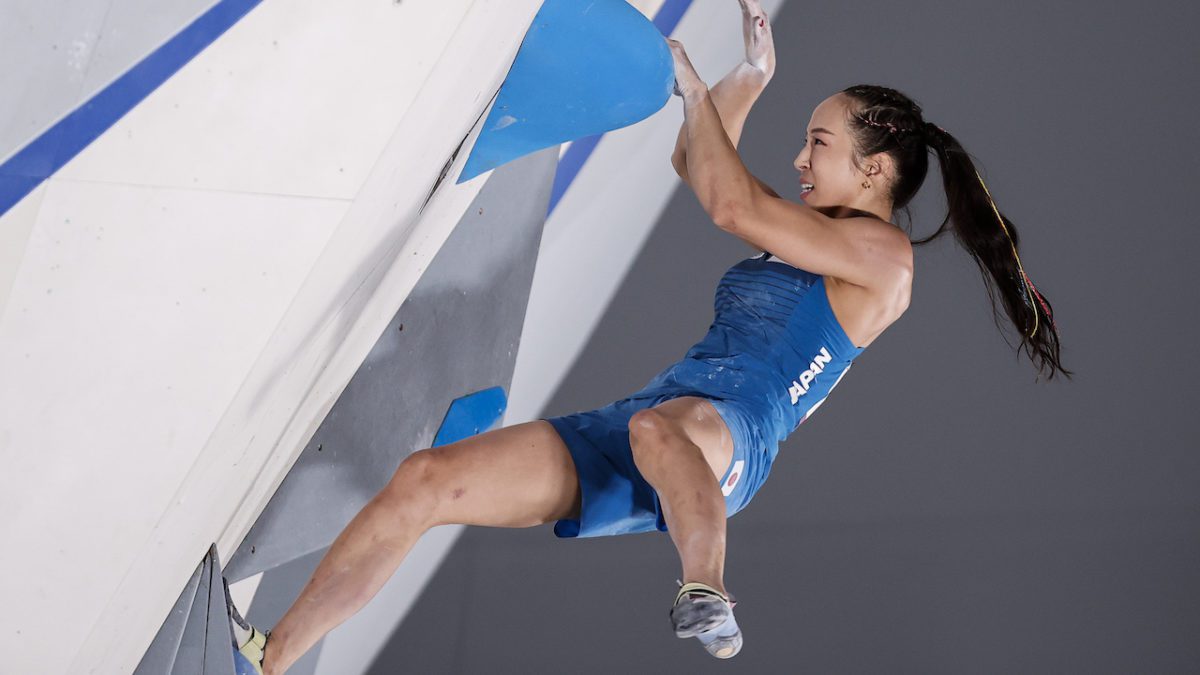 Photo by: Dimitris Tosidis of Akiyo Noguchi
Photo by: Dimitris Tosidis of Akiyo Noguchi
The Olympic combined format is a new kind of competition. Yesterday saw consternation surrounding how Finals might run given Bassa Mawem’s absence, while today saw Janja Garnbret fall far from the Lead round’s high-point. Things have become heated in Tokyo.

Speed
This morning’s event brought forward the 20 female competitors. Among these, Austria’s Jessica Pilz and Japan’s Miho Nonaka found themselves competing for the first time since injury. Where Pilz had an A4 pulley rupture in her left ring finger, Nonaka injured the ligaments in her right knee.
For any climber, rupturing a pulley can end a season. For an Olympian, it provides a challenging barrier this not easily overcome. If given perfect treatment, it takes six-to-eight weeks to heal. Today’s event fell around the nine-week mark.
While Nonaka’s fingers avoided injury, her last World Cup would damage the ligaments in her right knee. Although she would describe the injury as “not serious,” knees take a long time to heal. Even today, Nonaka climbed with in bandages.
With all of this in mind, the competition began. During the first heat, many athletes would watch their personal bests fall before them. Conversely, world record holder Iuliia Kaplina would fall in the first heat. The Russian would ultimately pull back on in the second heat, climbing with perfect flow until the last possible move. Foot slipping, what could have become a world record, pushed the athlete to a moderate 7.65.
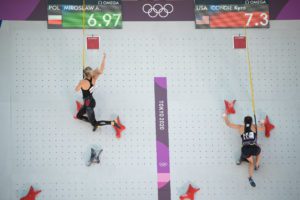
Although many climbers despise Speed’s inclusion in the Olympic format, few remember that even speed climbers find the format frustrating. Where Lead and Boulder specialists have two opportunities to climb well, Speed specialists almost have to make first if they want to compete in Finals. This is due to the shared strengths of the Lead and Boulder specialists. Where a Speed athlete might make first in Speed, they will likely place low in the other two disciplines. Without the first place multiplier from a won Speed event, it becomes extremely hard to make Finals
Taking first, Poland’s Aleksandra Miroslaw would climb and break her personal best in both heats. Miroslaw would ultimately set the Olympic record at 6.97 seconds. This time comes a mere hundredth of a second off of Kaplina’s world record. French speed climber Anouck Jaubert would follow Miroslaw with a time of 7.12 seconds. Against all odds, Jaubert would make her second place finish in Speed work.
Much like the Men’s field yesterday, several non-speed specialists also managed to climb well enough to secure good times. Japan’s Miho Nonaka climbed a 7.55 to secure fourth position. In a similar fashion, non-speed specialist Alannah Yip joined Nonaka under eight seconds. Canadian Olympian ran a 7.99.
With scores tallied, the athletes would look to Boulder with mixed levels of confidence.
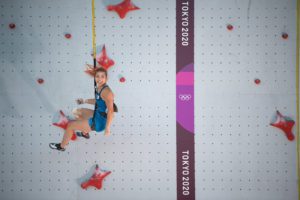
Boulder
The round began with South Africa’s Erin Sterkenberg flashing the Zone on B1. The classic slabby stand-up-slab into a coordinated catch would ultimately push the 18-year-old off the wall.
Russia’s Viktoriia Meshkova followed Sterkenberg and began what would become a strong round. Australia’s Oceana Mackenzie matched Meshkova’s result on B1, suggesting a low difficulty for the problem given these athletes’ rankings.
Much of the field would fail to find the finish following the first two ascents, but not quite as many as on B2. Italy’s Laura Rogora would struggle to find a top on B1. This, in addition to her punt of B2, would begin to upset the generally unshakable climber. Soon the stronger climbers filtered through B1 and many would send in a couple of tries.
Notably, Great Britain’s bouldering champion Shauna Coxsey would break the boulder with a match of the blocked intermediate. As the Tokyo Olympics will become Coxsey’s Final international performance, her skill on B1 excited spectators and athletes alike. Coxsey did compete in one Boulder World Cup in the 2021 season, however, the event appeared to describe an athlete with reduced strength. As the round progressed, Coxsey would refute such suppositions.

Only Slovenia’s Janja Garnbret would Flash B1. While this might appear regular for the Champion, Garnbret’s relatively poor performance in Speed appeared to have affected her self-confidence slightly. Her flash of B1 appeared to both relieve her and set the stage for the boulders to come.
Although B2 would see more tops than B3, it seemed harder than B1 suggesting progressive difficulty over the round. The problem revolved around a sloping compression sequence that climbers either topped, punted, or could not begin. This problem created real separation in the field and showcased American Brooke Raboutou and her ability. Of the Boulder leaders, only Noguchi would falter. She punted the last move several times before sending both of the final problems.
While Noguchi, and ultimately Garnbret, would complete B3, the boulder went unsent until Rogora forced her way to the Top. Raboutou would ultimately have to abandon the powerful, pressy bicep boulder, while Nonaka appeared to feel her wrist tweak in the under cling. This all preceded B4 rather well, as no one before Raboutou had managed to get beyond the Zone.
By contrast, Raboutou would campus her way through what appeared like a technical bottom sequence and proceeded to flash the boulder. The problem started inverted on stacked triangle volumes and forced climbers to move through inverted finger buckets, pasty feet and gibbed corners before the crimp sequence at the top. For those that did make it beyond the under-cling gib to the gibbed volume above, the end appeared simple.
While several athletes did touch this higher gib, few were able to use it. Noguchi and Garnbret would join Raboutou in flashing the boulder. In the end, Garnbret flashed all four boulder problems, but it appeared to take a toll. Lead would not climb as it normally does for the strong Slovenian.
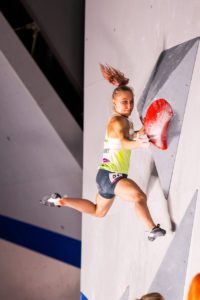
Lead
As with the Men’s round, Lead concluded the Women’s Qualification. After the last World Cups, the setters had to ensure separation occurred. In this year’s past events, the routes have offered relatively easy movement that would generally kick the athlete off by virtue of pump, or an angle-changing crux. This route was not easy.
In many ways, the sustained movement of the climb brought to mind yesterday’s Qualification round. The route continued dolling out hard moves. While the bottom featured a relatively simple series of readable edges, the top moved into sloping pinches that provided an aggressive amount of pump. Most athletes would fall on this pinch portion of the climb.
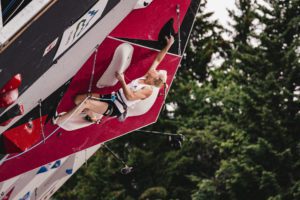
Once beyond the pumpy pinches, climbers would aim toward a final crimp sequence that still did not let up. By this point in the route, the climber would become so fatigued that each move offered a fight.
Out near the beginning, Meshkova would climb well once more. She moved through to the crimps beyond the slopers, establishing a high point for much of the round. Still, it would not be enough. Although the large moves would stump recent World Cup winner Laura Rogora, Korea’s Chaehyun Seo climbed 11 holds beyond Meshkova’s high point to cement a place in Finals.
Seo’s immense strength even defeated Garnbret in 2019 where she became the overall Lead World Cup winner. The 17-year-old crusher avoided the World Cup circuit in 2021, which made it difficult for some to predict her strength in today’s event.
Where Seo would surprise for strength, Garnbret, Nonaka and Noguchi would shock for falls lower than expected. By contrast, Jessica Pilz would not disappoint. She climbed well to the second-highest position. Even after not making top eight in Boulder, Pilz would establish herself in sixth position among her field. Despite injury, recovery, doubt and fear, Pilz and Nonaka would each overcome their injuries to make Finals.

Conclusions
In the end, Garnbret remains the favourite. Qualifying for Finals in first, it appears unlikely that anyone will be able to throw her from her throne. That said, she has left the door open. As Speed on Friday will take place through head-to-head match ups, anything could happen.
If Garnbret falls and Seo’s opponent also falls, Seo will have a legitimate chance of winning against Garnbret. This would require Seo having a stronger performance in Boulder than what occurred today, but the door is open.
For the other podium positions, Seo, Nonaka, Noguchi and Raboutou each have the opportunity to medal. Although France’s Anouck Jaubert climbed well enough to make Finals despite not winning Speed, podium will not come easy for her or Miroslaw.
Results
Advancing to Finals
1 – Janja Garnbret (SLO) 56.00
2 – Seo Chaehyun (KOR) 85.00
3 – Miho Nonaka (JPN) 96.00
4 – Akiyo Noguchi (JPN) 162.00
5 – Brooke Raboutou (USA) 192.00
6 – Jessica Pilz (AUT) 198.00
7 – Aleksandra Miroslaw (POL) 380
8 – Anouck Jaubert (FRA) 390
Men’s Finals begin August 5 at 4:30 am EST.
Women’s Finals begin August 4 at 4:30 am EST.


